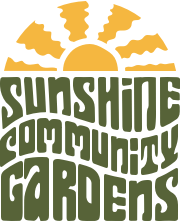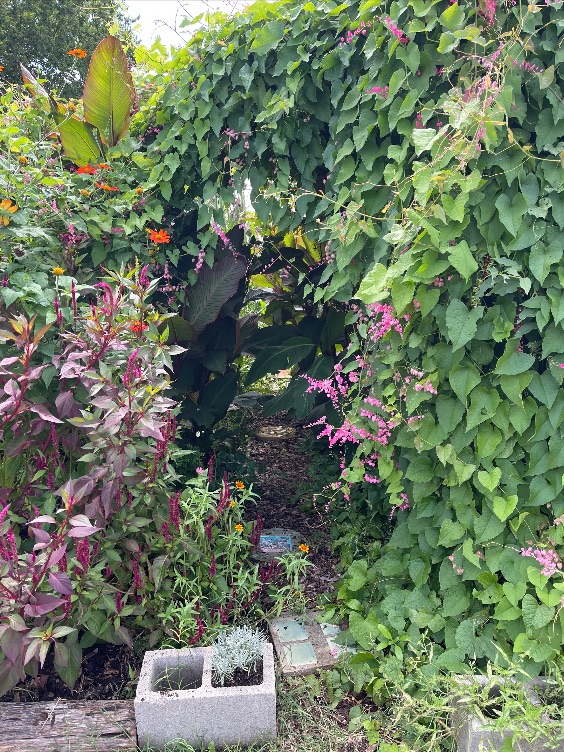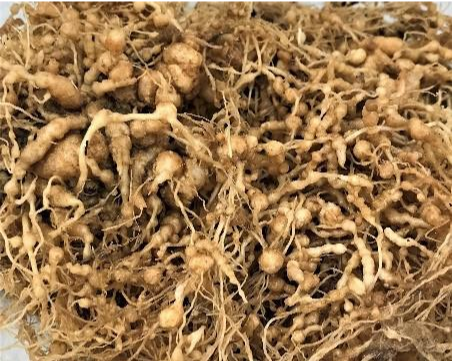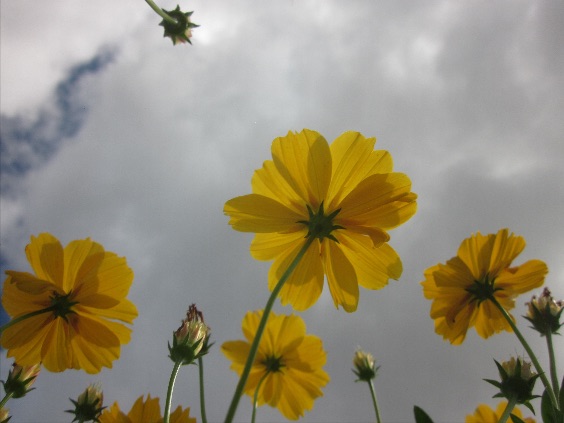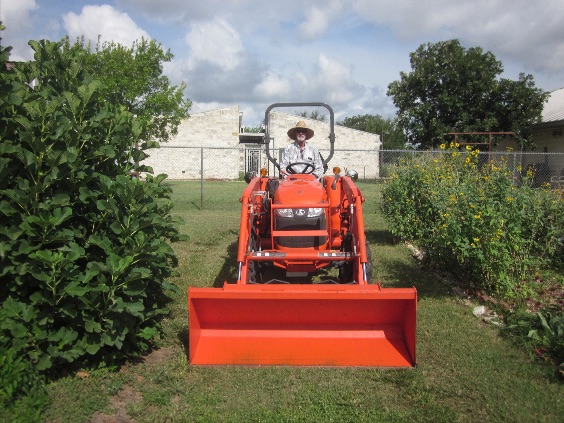
19 August, 2021
www.sunshinecommunitygardens.org
If you are signed up to receive the Weekly Weeder and have not been receiving it, here is a troubleshooting page to help. If this doesn't help, please let Sharon at scgardenweb@gmail.com know. Thanks.
In this Issue:
- Root Knot Nematodes
- Compost Coming Soon
- American Community Garden Association Conference
- Garden Tasks for Service Hours
Root Knot Nematodes
When you are pulling up your tomato plants, be sure to look at the roots. If they have bumps, then they are probably infected with Root Knot nematodes.
Infected roots should be cut off and not added to the compost pile. They should be put in the dumpster instead.
The following article provides excellent information about these organisms:
Win the Battle Against Root Knot Nematodes
by Sheryl Williams, Horticulture Program Assistant, Texas A&M AgriLife Extension-Travis County
Root knot nematodes (RKN) are a common soil born parasite here in Central Texas - even in the thin soils on the Edwards Plateau. Aggie Horticulture recently posted a video by Dr. Joe Masabni which mainly focuses on tomatoes because they are particularly susceptible. You can watch it on Facebook here.
A key characteristic of RKNs is that they are considered sedentary - meaning that they don't move in the soil more than an inch a year. This is why you can have one plant in a bed with RKN problems, but all the others are fine. Unfortunately, RKN infect a wide range of plants, have short generations times, and very high reproductive rates which negates their lack of mobility somewhat. The good news is that this sedentary habit gives you a good chance of controlling them in your garden. Here is the research paper that Dr. Masabni referred to in his video. It contains some great photos and discusses the efforts to breed RKN resistant tomatoes in Florida.
Above the ground, the symptoms of an infestation usually show plants that are doing poorly or not producing their normal amount of fruit or vegetative growth. You can confirm that it's RKN by pulling up the plant and examining the roots. The roots infected by RKN are thick, twisted, and may have large knots on them. Don't confuse this with the rhizobium nodules on legumes. Rhizobium bacteria also create root nodules from which they fix nitrogen in the air. They form on the outside of the root rather than the inside like RKN. Legumes in general are resistant to RKN.
Dr. Masabni highlights 11 options available to manage, control, or reduce the pressure of RKNs in your vegetable garden.
- Preplant Management. Do a regular inspection of your garden beds, especially if you are growing any of the nightshade family like tomatoes, peppers, potatoes, or eggplant. Pull these plants up when you have finished harvesting and inspect the roots for damage. You might also consider planting a few extra plants that you can pull up during the growing season to see if the RKN is present. This is a great strategy for those of you who try to baby your tomatoes through the summer.
- Crop Rotation. For me personally, this is my #1 garden practice for ALL pest management. Crop rotation means that you don't plant the same family in the same spot in subsequent growing seasons. An example of this is following your tomato garden bed with a planting of sweet corn or beans. Grasses may still be invaded by RKN, but the nematode can't reproduce in the roots - thus the population dies out. The Lubbock AgriLife office has an excellent post on crop rotation. You can find that here.
- Use of poor or non-host cover crops. Elbon or cereal rye (Secale cereale) is a great fall and winter cover crop here in Austin. The roots form a thick mat over the soil, allowing plenty of spots for nematodes to invade. As mentioned above, the RKN can't reproduce in grass roots, so within one growing season the population crashes. In the summer you can use sweet corn in the same way. I plant my corn in a 4" inch grid pattern for this very purpose. I thin the plants as they mature to the recommended spacing on the seed packet so that I get a good crop of ears. Dr. Masabni listed other cover crops for the commercial tomato growers. These are cowpeas (Vigna unguiculata,) , sunn hemp (Crotalaria juncea,) hairy indigo (Indigofera hirsute,) vetch (Aeschynomene americana,) and long-term pasture rotations.
- Weed control. Nutsedge is a host for RKN, so be sure to keep it under control in your vegetable beds.
- Clean fallow. The term "fallow" means that you leave the soil bare for a growing season. That includes removing weeds.
- Use resistant varieties. Most seed companies and plant labels list what diseases a plant has been bred to resist. Here is an example at Johnny's Seeds. A word of caution though, don't plant resistant varieties year after year or you will end up selecting for resistant nematodes!
- Flooding. You can alternate 2-3 week cycles of flooding and drying. That's probably not an option here in Austin.
- Immediate field clean up after final harvest. This means pulling the plant up or killing it through tillage.
- Solarization. Travis County Master Gardener Ann Roe helped write a blog post on this. You can read it here.
- Grafting. Dr. Masabni goes into this in some detail in his video.
- Use of resistant root stock. If you're going to buy grafted tomatoes, make sure they are on resistant root stock.
The author of this article, Sheryl Williams, may be contacted at sheryl.williams@ag.tamu.edu.
Compost Coming Soon
Randy Thompson says he plans to order compost by the end of August -- in time for gardeners to use the compost to ready their plots for fall planting.
FYI: American Community Garden Association Conference
Sunshine has renewed its organizational membership with the American Community Garden Association (ACGA). ACGA will be holding a conference in Hampton, VA in late September. This year the conference theme will be "Gardening in Challenging Times." To read more about the conference or to learn more about this organization and the resources it has for community gardeners, please visit here.
Priority (Tasks specifically needed):
- Digging up khaki weed, wherever you find it (Counts as TSVBI hours).
- Maintaining common paths and common areas. If you have plants extending into common paths, trim them. The common paths are designed to allow the biggest wheelbarrows that we own to traverse them unimpeded.
- Removing hackberries and Johnson grass growing in cyclone fence around Sunshine. (Please try to dig out as much of the roots as possible. Hackberries should be cut off as deep below ground level as possible.)
TSBVI:
- Weeding paths in TSBVI garden and wood chip areas on west side. (This is normally needed. Try to get out roots. Be sure to smooth out paths after weeding to facilitate TSBVI students moving around garden.)
- Mowing between fence and street along 49th St. and Sunshine Dr. along and 10' inside fence. (Frequent mowing will be needed this timeof year.)
- Picking up trash in compost area and along fencelines.
- Cleaning street curb gutters of dirt and debris build up. (At places in the curb gutter along Sunshine Dr. and 49th St., soil and debris has built has up and grass beginning to grow. Scrape off with shovel and put in wheelbarrow. If debris is gravel, can be put in low places in parking lot. Otherwise, put in dumpster.)
Regular:
- Mowing (Please check area around trailer and greenhouses. Frequent mowing will be needed this time of year.)
- Maintaining common paths. (Gardeners are required to maintain a 2' strip of common paths adjacent to their plot.)
- Mowing and cleaning up overgrown/messy places in common areas.
Note: TSBVI hour tasks can also count as regular hours.
Sunshine Vice President Steve Camp says, "I know that everyone is eager to get to the Garden to pull khaki weed and perform other tasks, put please try to subdue that eagerness by keeping your speed limit less than or equal to 3 MPH."
Weeder Content
Please submit
weekly weeder articles, photos, and recipes by Wednesday to both Co-Editors:
Holly Gilman at hollyjgilman@gmail.com and
Maria Beach at dr.maria.beach@gmail.com
Officer and Zone Coordinator Contacts - Sunshine Gardens
Officers
- President - James "Jim" Willmann jhwillmann@gmail.com
- Vice-President - Steve Camp campinthegarden@yahoo.com
- Secretary - Kerry Drake kerryadrake@gmail.com
- Treasurer - Debra Marino scgtreasurer1@gmail.com
- Director - Kay McMurry scg.plots@gmail.com
- Director - Marsha Riti marshariti@gmail.com
- Director - Doug Zullo dugzoo@gmail.com
Email the board.
Zone Coordinators
- Zone 1, Susan Wallar swallar@gmail.com
- Zone 2, Wayne Kuenstler wckuenstler@gmail.com
- Zone 3, Ludmila Voskov lvoskov@austin.rr.com
- Zone 4, Ila Falvey ila.falvey@gmail.com
- Zone 5, Mary Gifford mgifford@austin.rr.com
- Zone 6, Charlotte Jernigan charlotte@cybermesa.com
- Zone 7, Jeff Schulz chilihead.schulz@gmail.com
- Zone 8, Steve Uecker steven_uecker@hotmail.com
- Zone 9, Kerry Howell casonhowell@gmail.com
- Zone 10, Christopher Schroder
christopher.s.schroder@gmail.com &
Karl Arcuri karl.w.arcuri@gmail.com
Other Personnel
- Weekly Weeder Newsletter - Holly Gilman hollyjgilman@gmail.com
- Weekly Weeder Newsletter - Maria Beach dr.maria.beach@gmail.com
- Plant Sale - Randy Thompson & Janet Adams jartdaht@gmailcom
- TSBVI Liaison & Volunteer Coordinator - TBA
- Plot Assignment - Kay McMurry scg.plots@gmail.com
- Compost Coordinator - Janet Adams jartdaht@gmail.com
- Carpentry & Repairs - Robert Jarry r.jarry@sbcglobal.net
- Water Leak Repairs - Steve Schulz sschulz784@aol.com
- Tools & Wheelbarrows - Bob Easter bob@easterandeaster.com
- Gas Mowers - Ray Porter Gasmowers@icloud.com
- Cordless Mowers/Trimmers - Steve Camp stcole431@yahoo.com
- Kitchen Supplies - Anita Keese
anodekraft1@msn.com
(If supplies are needed for events, contact by email or at 512-773-2178) - Compost Tea -
- Micah 6 - Dana Kuykendall kuykendall@austin.rr.com
- Micah 6 - Mary Gifford mgifford@austin.rr.com
- Micah 6 - Walter Kuhl kuhlwalter088@gmail.com
- Website Coordinator - Sharon Rempert scgardenweb@gmail.com
Record Service Hours Online - Green Binder
